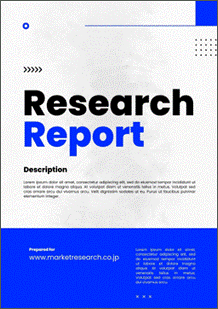 | • レポートコード:MRC2108A230 • 出版社/出版日:Mordor Intelligence / 2021年7月 • レポート形態:英文、PDF、68ページ • 納品方法:Eメール(受注後2-3営業日) • 産業分類:医療 |
| Single User | ¥481,000 (USD3,250) | ▷ お問い合わせ |
| Team User | ¥555,000 (USD3,750) | ▷ お問い合わせ |
| Corporate License | ¥962,000 (USD6,500) | ▷ お問い合わせ |
• お支払方法:銀行振込(納品後、ご請求書送付)
レポート概要
| Mordor Intelligence社は、AYUSH&代替医療のインド市場規模が、2021年から2026年の間に年平均8.6%成長すると予測しています。本調査レポートは、インドのAYUSH&代替医療市場について調査・分析し、イントロダクション、調査手法、エグゼクティブサマリー、市場動向、種類別分析、競争状況、市場機会・将来の見通しなどを掲載しています。 |
AYUSH and alternative medicine industry in India is expected to register a CAGR of 8.6% during the forecast period.
In the context of COVID-19, the market for alternative medicines, like Ayurveda, has been increasing due to the increasing demand for various ayurvedic products to boost immunity. As per a report published in August 2020, since March, the demand for honey has gone up 45%, chyawanprash by 85%, and turmeric by 40% in ayurvedic stores. The interest in these products has mostly been fueled by the recommendations from the Ministry of AYUSH to fight COVID-19.
The system of alternative medicines in India consists of Ayurveda, yoga, naturopathy, Unani, Siddha, and homeopathy (AYUSH). Due to the abundance of ancient scientific knowledge, India is considered the hub for alternative medicines, like Unani, Ayurveda, Siddha, and homeopathy. The market currently is experiencing a surge in demand for AYUSH and alternative medicines in India, owing to the growing awareness about the effectiveness and efficacy of traditional systems of medicine, coupled with increasing initiatives by the government to support these systems and rising R&D. In September 2020, the Parliament of India passed two bills to improve access to quality and affordable medical education by ensuring the availability of adequate and high-quality homeopathy and other AYUSH medicines across the country.
Additionally, in August 2020, the Gujarat health department reported that they had distributed the homeopathic drug Arsenicum Album-30, as prophylaxis treatment to approximately 3.48 crore people, which is more than half of the Gujrat’s population since March 2020, after the COVID-19 outbreak. These medicines are cost-effective as compared to other synthetic products. At present, India is also one of the top exporters of alternative medicines in the world. Major export destination includes the United States and European countries, like Germany and France. The government of India is continuously supporting the industry with investments in scientific research in AYUSH, building the necessary infrastructure and regulatory framework to regulate this system of medicine. However, one of the major factors hindering the growth of the Indian AYUSH and alternative medicine market is the general perception of the treatment as a secondary source of medication.
Key Market Trends
Ayurveda to Dominate Market Share
Ayurvedic medicine was originated in India and has been around in clinical usefulness for the past many decades. The segment is driven by a rising initiative by the government to support ayurvedic medicine in India coupled with the increasing adoption of these systems of medicine around the world. In 2017, the Indian government passed the National Health Mission and National Health Policy-2017 for promoting and strengthening the ayurvedic sector, including financial support, including infrastructure development, and supply of medicines to the dispensaries and hospitals in the states.
Additionally, in November 2020, the World Health Organisation (WHO) selected India to set up a traditional medicine center to strengthen research, training, and awareness of Ayurveda. After the announcement, the Indian government inaugurated two Ayurveda institutions, the Institute of Teaching and Research in Ayurveda (ITRA), Jamnagar (Gujarat), and the National Institute of Ayurveda (NIA), Jaipur. Additionally, the government is focusing on R&D and is fueling market growth. For instance, in January 2020, IIT Delhi and the All India Institute of Ayurveda signed an MoU to study the therapeutic benefits of herbal formulations and wellness. The government planned seven collaborations focusing on various Ayurvedic formulations and for the next two years. Hence, owing to all of these developments, the market studied is anticipated to have a positive growth over the forecast period.
Competitive Landscape
The future of the AYUSH and alternative medicine industry is lucrative, as more and more players are entering the market with innovative products, quality packaging, and strategic marketing activities. Earlier, companies in the natural medicine market failed in attracting consumers as a result of a lack of promotional activities and poor presentation of products. However, the new generation of entrepreneurs is working and focusing on these aspects to partake in the growing market competition. Various manufacturing companies are focusing on investing in marketing strategies to generate awareness and increase their brand value and sales. All these underlying factors are anticipated to drive the AYUSH and alternative medicine market in the country over the forecast period.
Reasons to Purchase this report:
- The market estimate (ME) sheet in Excel format
- 3 months of analyst support
1 INTRODUCTION
1.1 Study Assumptions and Market Definition
1.2 Scope of the Study
2 RESEARCH METHODOLOGY
3 EXECUTIVE SUMMARY
4 MARKET DYNAMICS
4.1 Market Overview
4.2 Market Drivers
4.2.1 Increasing Government Initiatives
4.2.2 Growing Awareness About the Effectiveness and Efficacy of Traditional Systems of Medicine
4.2.3 Increase in the R&D Activities
4.3 Market Restraints
4.3.1 Lack of World-class Treatment Centers
4.3.2 Lack of Health Insurance Approval and Scientific Validation
4.4 Industry Attractiveness – Porter’s Five Forces Analysis
4.4.1 Bargaining Power of Buyers/Consumers
4.4.2 Bargaining Power of Suppliers
4.4.3 Threat of New Entrants
4.4.4 Threat of Substitute Products
4.4.5 Intensity of Competitive Rivalry
5 MARKET SEGMENTATION
5.1 By Type
5.1.1 Ayurvedic Medicine
5.1.2 Herbal Medicine
5.1.3 Aroma Therapy
5.1.4 Homeopathy
5.1.5 Acupuncture
5.1.6 Other Types
6 COMPETITIVE LANDSCAPE
6.1 Company Profiles
6.1.1 Baidyanath
6.1.2 Dabur India
6.1.3 Ganga Pharmaceuticals
6.1.4 GR Herbals
6.1.5 Hamdard
6.1.6 Himalaya Wellness
6.1.7 Hootone Remedies
6.1.8 Patanjali Ayurved Limited
6.1.9 SBL Mathur
6.1.10 Sydler India Pvt. Ltd
7 MARKET OPPORTUNITIES AND FUTURE TRENDS